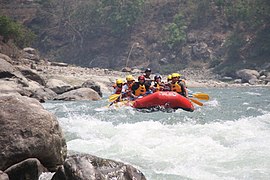Rafting in Nepal
Rafting, Kayaking and Cannoning is one of the main parts of river tourism in Nepal. Prior to the boom of the tourism industry, rivers were considered holy and the idea of fun in the river was not usual to general Nepalese.[1] From zero clients in early 70s to more than 30,000 clients in 2000, it is one of the growing industry of Nepal. [2]: 45

History
[edit]The first commercial rafting company, Himalayan River and exploration, was registered in 1976 by Al Read. This was the first rafting company not only in Nepal but the entire Asia. The headquarter of the company was in Kathmandu and was run by American and Nepali staffs. In 1976, over 100 Nepalese were trained for the rafting job. These trainees later started their own rafting companies.[2]: 42-51
In 1989, Nepal Association of Rafting Agents was formally recognized by the Government. Initially, the Government required that all rafting clients pay for a permit that allowed them to participate in a rafting trip on a particular river for a specified number of days. This system was revoked in 1999.[2]: 42-51
Rivers
[edit]Rafting is allowed in all the rivers of Nepal.[citation needed] Some disturbance has been observed due to the construction of dams and weirs for hydropower production.[citation needed] Some popular river for rafting are listed below.[3][4]
| River | Length (km) | Rapid class |
|---|---|---|
| Karnali River | 180 | Class IV – V |
| Tamur River | 120 | Class IV |
| Sunkoshi River | 270 | Class III – IV |
| Tamur River | 120 | Class IV |
| Kali Gandaki River | 90 | Class IV – V |
| Seti River | Class III – IV | |
| Bhotekoshi River | 22 | Class III to V |
| Trisuli River | Class III – IV | |
| Marshyangdi River | 27 | Class IV – V |
| Bheri River | 105 | Class III |
Rafting seasons
[edit]During the monsoon from early June to mid-September, rivers are flooded and rafting is dangerous and is not carried out. During other seasons mainly spring (March–May) and autumn (September–November) is considered good for rafting.[5] During spring, flow can be quite low in smaller river. Additionally, the blowing wind on some rivers, such as the Karnali, can be an annoyance.[5]
Safety and Accidents
[edit]Safety guidelines specific to rafting has not been published. Each operator has their own safety protocols. [citation needed] Due to which accidents occur time and again every year. Few fatalities are reported every year. Some of them are:
Gallery
[edit]-
Trisuli
-
Bhotekoshi
External links
[edit]References
[edit]- ^ Knowles, Peter; Allardice, Dave (1992). White Water Nepal: A Rivers Guidebook for Rafting and Kayaking. Rivers Publishing UK. ISBN 0-9519413-0-5.
- ^ a b c Van De Berg, William Roger (2003). "Whitewater rafting in Nepal: an anthropological analysis of participation in the global tourism industry".
{{cite journal}}: Cite journal requires|journal=(help) - ^ "Top 10 Rafting Tours in Nepal - Rafting in Nepal Overview". Bookmundi.com. Retrieved 2020-08-25.
- ^ "Rafting in Nepal". Trekking in Nepal. Retrieved 2020-08-25.
- ^ a b Turner, Elen. "A Guide to White Water Rafting in Nepal". Culture Trip. Retrieved 2020-08-25.
- ^ "Australian dies in Nepal rafting accident". SBS News. Retrieved 2020-08-25.
- ^ "Australian woman killed in kayak accident near Pokhara in Nepal". The New Daily. 2018-12-03. Retrieved 2020-08-25.
- ^ "French man dies in rafting accident". Retrieved 2020-08-25.
- ^ "The Rising Nepal: Youth missing after rafting accident in Trishuli". Retrieved 2020-08-25.


